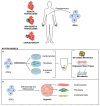Three-Dimensional iPSC-Based In Vitro Cardiac Models for Biomedical and Pharmaceutical Research Applications
- PMID: 39409018
- PMCID: PMC11477044
- DOI: 10.3390/ijms251910690
Three-Dimensional iPSC-Based In Vitro Cardiac Models for Biomedical and Pharmaceutical Research Applications
Abstract
Cardiovascular diseases are a major cause of death worldwide. Advanced in vitro models can be the key stone for a better understanding of the mechanisms at the basis of the different pathologies, supporting the development of novel therapeutic protocols. In particular, the implementation of induced pluripotent stem cell (iPSC) technology allows for the generation of a patient-specific pluripotent cell line that is able to differentiate in several organ-specific cell subsets while retaining the patient genetic background, thus putting the basis for personalized in vitro modeling toward personalized medicine. The design of iPSC-based models able to recapitulate the complexity of the cardiac environment is a critical goal. Here, we review some of the published efforts to exploit three dimensional (3D) iPSC-based methods to recapitulate the relevant cardiomyopathies, including genetically and non-genetically determined cardiomyopathies and cardiotoxicity studies. Finally, we discuss the actual method limitations and the future perspectives in the field.
Keywords: cardiac; cardiomyopathy; engineered heart tissue; in vitro modeling; microtissue; organoid.
Conflict of interest statement
The authors declare no conflicts of interest.
Figures
References
Publication types
MeSH terms
Grants and funding
LinkOut - more resources
Full Text Sources


